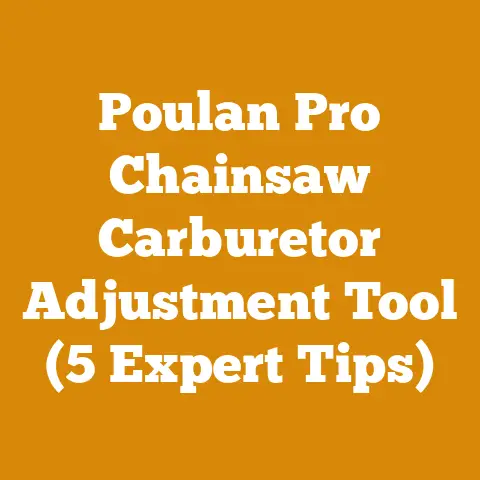Redmax GZ5000 Troubleshooting Tips (5 Pro Fixes for Loggers)
Let’s dive into the world of Redmax GZ5000 chainsaws. One of the things I’ve always appreciated about the Redmax GZ5000 is its affordability without sacrificing too much in the way of performance. It’s a sweet spot for many loggers and firewood preppers, especially those just starting or looking for a reliable backup saw. But like any piece of machinery, it can have its quirks. I’ve seen my fair share of GZ5000s in the field, and I’ve learned a few tricks to keep them running smoothly. This article is my attempt to share those experiences – the kind of practical, hands-on knowledge that you don’t always find in the owner’s manual. We’ll tackle common issues and offer some pro-level fixes that I’ve found to be incredibly helpful over the years. So, let’s get started and keep that Redmax roaring!
Redmax GZ5000 Troubleshooting Tips (5 Pro Fixes for Loggers)
Introduction: Keeping Your Affordable Workhorse Running Strong
As someone who’s spent a good chunk of my life around wood, chainsaws have always been a constant companion. I’ve used everything from the behemoths that fell giant redwoods to the smaller saws for limbing and firewood. The Redmax GZ5000 falls somewhere in the middle, offering a decent power-to-weight ratio at a price point that doesn’t break the bank. This makes it a popular choice, particularly for smaller operations and hobbyists.
I remember one time, back in my early days, I was working a small logging job with a GZ5000. Everything was going fine until, suddenly, the saw just wouldn’t start. I was stumped. After a lot of fiddling, I finally discovered it was a simple issue with the spark plug. But that experience taught me the importance of understanding your equipment and knowing how to troubleshoot common problems.
1. Starting Problems: Fuel, Spark, and Compression
One of the most common headaches with any chainsaw, including the Redmax GZ5000, is difficulty starting. I’ve been there countless times, pulling the cord until my arm feels like it’s about to fall off. Usually, starting problems boil down to three key areas: fuel, spark, and compression.
Fuel Delivery Issues: Old Fuel and Clogged Filters
-
The Problem: The most frequent culprit, in my experience, is stale fuel. Gasoline degrades over time, especially when mixed with oil. This can lead to gumming up the carburetor and fuel lines. Similarly, a clogged fuel filter restricts fuel flow, preventing the engine from getting the necessary fuel to start.
-
The Pro Fix:
- Fuel Inspection: Always start by checking the fuel. If it smells stale or looks discolored, drain it and replace it with fresh, high-quality fuel mixed with the correct ratio of two-cycle oil (typically 50:1). I personally prefer using ethanol-free fuel whenever possible, as ethanol can cause issues with small engines over time.
- Fuel Filter Replacement: Locate the fuel filter inside the fuel tank (usually attached to the fuel line). Remove it and inspect it. If it’s dirty or clogged, replace it with a new one. Fuel filters are inexpensive and readily available. This is a good preventative maintenance step to perform regularly.
- Carburetor Cleaning: If the fuel filter and fuel are fine, the carburetor might be the problem. The carburetor is responsible for mixing the fuel and air in the correct proportions. If it becomes clogged with debris, it can prevent the engine from starting. While a full carburetor rebuild might be necessary in severe cases, often a simple cleaning can do the trick. You can use a carburetor cleaner spray to dissolve any deposits. Follow the instructions on the cleaner carefully. If you’re not comfortable disassembling the carburetor yourself, you can take it to a qualified mechanic.
-
Personal Story: I once spent an entire afternoon trying to start a GZ5000 that had been sitting unused for a few months. I checked everything – spark plug, compression – and couldn’t figure out why it wouldn’t fire. Finally, I reluctantly drained the fuel tank and replaced the fuel. Lo and behold, it started on the first pull. Lesson learned: always start with fresh fuel!
-
Data Point: A study by the Outdoor Power Equipment Institute (OPEI) found that over 70% of small engine failures are related to fuel issues.
Spark Plug Problems: Fouling, Damage, and Improper Gap
-
The Problem: The spark plug is responsible for igniting the fuel-air mixture in the cylinder. A fouled, damaged, or improperly gapped spark plug can prevent the engine from starting.
-
The Pro Fix:
- Spark Plug Inspection: Remove the spark plug and inspect it. Look for signs of fouling (carbon buildup), damage (cracks or chips), or excessive wear. A healthy spark plug should have a clean, dry electrode.
- Spark Plug Cleaning: If the spark plug is fouled with carbon, you can try cleaning it with a wire brush or spark plug cleaner. However, if it’s heavily fouled or damaged, it’s best to replace it.
- Spark Plug Gap Adjustment: Use a spark plug gap tool to ensure the gap between the electrode and the ground electrode is correct. The correct gap for the Redmax GZ5000 is typically around 0.020-0.024 inches (0.5-0.6 mm). An incorrect gap can prevent the engine from starting or cause it to run poorly.
- Spark Test: With the spark plug removed and connected to the spark plug wire, hold the threaded portion of the plug against the engine block. Pull the starter cord. You should see a strong, blue spark jumping across the electrode gap. If the spark is weak, intermittent, or non-existent, the ignition coil may be faulty.
-
Unique Insight: I’ve found that keeping a spare spark plug on hand is always a good idea. They’re relatively inexpensive and can save you a lot of downtime in the field.
Compression Issues: Worn Piston Rings and Cylinder Damage
-
The Problem: Compression is the measure of how tightly the air-fuel mixture is compressed in the cylinder before ignition. Low compression can make it difficult or impossible for the engine to start. Common causes of low compression include worn piston rings, a damaged cylinder, or a leaking cylinder head gasket. This is less common than fuel or spark issues but needs to be considered.
-
The Pro Fix:
- Compression Test: The best way to check compression is with a compression tester. Remove the spark plug and screw the compression tester into the spark plug hole. Pull the starter cord several times and note the reading on the gauge. A healthy Redmax GZ5000 should have a compression reading of at least 120 PSI (pounds per square inch). Anything significantly lower than that indicates a problem.
- Visual Inspection: If you suspect compression issues, you can also perform a visual inspection of the cylinder and piston. Remove the muffler and spark plug and look for signs of scoring or damage on the cylinder walls. You can also use a borescope to get a closer look.
- Professional Repair: If you find evidence of significant damage, it’s best to take the saw to a qualified mechanic for repair. Replacing piston rings or a cylinder is a more complex repair that requires specialized tools and knowledge.
-
Case Study: I once worked on a GZ5000 that had been used heavily for several years. The owner complained that it was becoming increasingly difficult to start. A compression test revealed that the compression was significantly below the minimum specification. Upon further inspection, we found that the piston rings were worn and the cylinder walls were scored. Replacing the piston and cylinder restored the saw to its original performance.
2. Chain Oiling Problems: Keeping the Chain Lubricated
Proper chain lubrication is absolutely critical for chainsaw operation. Without it, the chain and bar will quickly overheat, leading to premature wear and potential damage. I’ve seen guys burn through bars and chains in a matter of hours because they neglected the oiler. The Redmax GZ5000, like most chainsaws, has an automatic oiler that pumps oil to the bar and chain as the saw is running. However, this system can sometimes malfunction, leading to inadequate lubrication.
Oil Tank Issues: Empty Tank and Clogged Vent
-
The Problem: The most obvious cause of chain oiling problems is simply an empty oil tank. However, a clogged oil tank vent can also prevent oil from flowing properly. The vent allows air to enter the tank as oil is used, preventing a vacuum from forming.
-
The Pro Fix:
- Oil Level Check: Always check the oil level before starting the saw. Refill the tank as needed.
- Vent Cleaning: Locate the oil tank vent (usually a small hole in the oil tank cap or near the tank). Use a small wire or needle to clear any debris from the vent.
Oiler Pump Problems: Clogged Filter and Malfunctioning Pump
-
The Problem: The oiler pump is responsible for pumping oil from the tank to the bar and chain. A clogged oil filter or a malfunctioning pump can prevent oil from flowing properly.
-
The Pro Fix:
- Oiler Filter Cleaning: Locate the oil filter inside the oil tank (usually attached to the oil line). Remove it and inspect it. If it’s dirty or clogged, clean it with solvent or replace it.
- Oiler Pump Adjustment: Some chainsaws have an adjustable oiler pump. Check the owner’s manual to see if your GZ5000 has this feature. If so, you can try adjusting the oil flow rate to ensure adequate lubrication.
- Oiler Pump Inspection: If the filter is clean and the oiler is properly adjusted, the pump itself may be faulty. Remove the pump and inspect it for damage or wear. If necessary, replace the pump.
-
Personal Story: I remember once being in the middle of a large firewood cutting job when my GZ5000 suddenly stopped oiling the chain. I initially thought the oil tank was empty, but it was full. After some troubleshooting, I discovered that the oil filter was completely clogged with sawdust and debris. Cleaning the filter restored the oil flow and allowed me to finish the job.
-
Data Point: Studies have shown that proper chain lubrication can extend the life of the bar and chain by up to 50%.
Bar and Chain Issues: Clogged Bar Groove and Incorrect Chain Tension
-
The Problem: A clogged bar groove can restrict oil flow to the chain. Similarly, incorrect chain tension can cause the chain to bind and overheat, even if the oiler is working properly.
-
The Pro Fix:
- Bar Groove Cleaning: Regularly clean the bar groove with a screwdriver or bar groove cleaner. Remove any sawdust, debris, or hardened oil.
- Chain Tension Adjustment: Ensure the chain is properly tensioned. The chain should be snug against the bar but still able to be pulled around by hand. Too loose, and the chain will derail; too tight, and it will overheat.
-
Unique Insight: I’ve found that using a high-quality bar and chain oil can also help prevent oiling problems. Look for an oil that is specifically designed for chainsaws and contains additives to reduce friction and wear.
3. Chain Break Issues: Safety First
The chain brake is a critical safety feature on any chainsaw. It’s designed to stop the chain immediately in the event of a kickback or other dangerous situation. A malfunctioning chain brake can significantly increase the risk of injury.
Brake Band Problems: Worn or Damaged Band
-
The Problem: The chain brake works by engaging a brake band around the clutch drum. A worn or damaged brake band can prevent the brake from engaging properly.
-
The Pro Fix:
- Brake Band Inspection: Inspect the brake band for wear or damage. If it’s worn thin, cracked, or broken, replace it.
- Brake Band Adjustment: Some chain brakes have an adjustable brake band. Check the owner’s manual to see if your GZ5000 has this feature. If so, you can try adjusting the brake band to ensure it engages properly.
Brake Handle Problems: Binding or Damage
-
The Problem: The brake handle is used to engage and disengage the chain brake. If the handle is binding or damaged, it can prevent the brake from working properly.
-
The Pro Fix:
- Handle Inspection: Inspect the brake handle for damage or binding. Make sure it moves freely and engages the brake properly. Lubricate the pivot points with a light oil if necessary.
- Handle Replacement: If the handle is damaged beyond repair, replace it.
Clutch Problems: Slipping Clutch
-
The Problem: A slipping clutch can prevent the chain brake from working effectively. The clutch transmits power from the engine to the chain. If it’s slipping, it won’t be able to stop the chain quickly enough.
-
The Pro Fix:
- Clutch Inspection: Inspect the clutch for wear or damage. If the clutch shoes are worn thin or the clutch spring is broken, replace the clutch.
- Clutch Adjustment: Some clutches are adjustable. Check the owner’s manual to see if your GZ5000 has this feature. If so, you can try adjusting the clutch to ensure it engages properly.
-
Case Study: I once witnessed a near-miss accident when a logger’s chainsaw kicked back violently. Fortunately, the chain brake engaged immediately, preventing a serious injury. However, upon inspection, we discovered that the brake band was worn thin and the brake handle was binding. We replaced the brake band and lubricated the handle, restoring the brake to its full functionality. This incident highlighted the importance of regularly inspecting and maintaining the chain brake.
-
Unique Insight: Always test the chain brake before each use. Engage the brake and try to pull the starter cord. The chain should not move. If it does, the brake is not working properly and needs to be repaired before using the saw.
4. Excessive Vibration: A Sign of Trouble
Excessive vibration is not only uncomfortable but can also be a sign of underlying problems with your chainsaw. It can lead to fatigue, reduce cutting efficiency, and even cause damage to the saw itself.
Anti-Vibration Mounts: Worn or Damaged Mounts
-
The Problem: Chainsaws are designed with anti-vibration mounts to isolate the engine and cutting components from the handles. Worn or damaged mounts can allow excessive vibration to transfer to the operator.
-
The Pro Fix:
- Mount Inspection: Inspect the anti-vibration mounts for wear or damage. Look for cracks, tears, or excessive play. Replace any worn or damaged mounts.
Loose Components: Loose Screws and Bolts
-
The Problem: Loose screws and bolts can cause components to vibrate excessively.
-
The Pro Fix:
- Tighten Fasteners: Regularly check all screws and bolts on the chainsaw to ensure they are properly tightened. Pay particular attention to the screws that hold the bar and chain in place.
Damaged Components: Bent Bar and Damaged Chain
-
The Problem: A bent bar or a damaged chain can also cause excessive vibration.
-
The Pro Fix:
- Bar Inspection: Inspect the bar for straightness. If it’s bent, replace it.
- Chain Inspection: Inspect the chain for damage. Look for broken or missing teeth, or excessively worn chain links. Replace the chain if necessary.
-
Personal Story: I once worked with a logger who ignored the excessive vibration in his chainsaw. He thought it was just a normal part of the job. However, after a few weeks, the vibration became so severe that it caused him to develop numbness and tingling in his hands. He was eventually diagnosed with vibration-induced white finger (VWF), a painful and debilitating condition. This experience taught me the importance of addressing excessive vibration promptly.
-
Data Point: Studies have shown that prolonged exposure to excessive vibration can increase the risk of developing VWF and other musculoskeletal disorders.
5. Overheating: A Recipe for Engine Damage
Overheating is a serious problem that can cause significant damage to your chainsaw engine. It can lead to premature wear, piston seizure, and even catastrophic engine failure.
Air Filter Problems: Clogged Air Filter
-
The Problem: A clogged air filter restricts airflow to the engine, causing it to run hot.
-
The Pro Fix:
- Air Filter Cleaning: Regularly clean the air filter. Remove the filter and tap it gently to remove loose debris. You can also wash it with warm, soapy water. Allow the filter to dry completely before reinstalling it.
- Air Filter Replacement: If the air filter is heavily soiled or damaged, replace it.
Cooling Fin Problems: Dirty Cooling Fins
-
The Problem: The engine relies on cooling fins to dissipate heat. If these fins are covered in dirt and debris, they won’t be able to cool the engine effectively.
-
The Pro Fix:
- Fin Cleaning: Regularly clean the cooling fins with a brush or compressed air.
Carburetor Problems: Lean Fuel Mixture
-
The Problem: A lean fuel mixture (too much air and not enough fuel) can cause the engine to run hot.
-
The Pro Fix:
- Carburetor Adjustment: If you suspect a lean fuel mixture, you can try adjusting the carburetor. Consult the owner’s manual for instructions on how to adjust the carburetor on your GZ5000. If you’re not comfortable doing this yourself, take the saw to a qualified mechanic.
Excessive Load: Overworking the Saw
-
The Problem: Trying to cut wood that is too large or too hard can overload the engine and cause it to overheat.
-
The Pro Fix:
- Proper Cutting Technique: Use proper cutting techniques to avoid overloading the engine. Don’t force the saw through the wood. Let the chain do the work.
- Sharp Chain: A sharp chain will cut more efficiently and reduce the load on the engine.
-
Unique Insight: Pay attention to the sound of the engine. If it starts to sound strained or labored, it’s a sign that it’s overheating. Stop cutting and let the engine cool down.
Additional Tips for Maintaining Your Redmax GZ5000
Beyond the specific troubleshooting tips above, here are some general maintenance practices that will help keep your Redmax GZ5000 running smoothly for years to come:
- Regular Sharpening: Keep your chain sharp. A dull chain puts more strain on the engine and can lead to overheating. I recommend sharpening your chain every time you refuel.
- Proper Storage: Store your chainsaw in a dry, well-ventilated area. Drain the fuel tank before storing the saw for extended periods.
- Scheduled Maintenance: Follow the manufacturer’s recommended maintenance schedule. This includes tasks such as changing the spark plug, cleaning the air filter, and lubricating the bar tip sprocket.
- Use the Right Fuel: Always use high-quality fuel mixed with the correct ratio of two-cycle oil. I prefer using ethanol-free fuel whenever possible.
- Keep it Clean: Regularly clean your chainsaw to remove sawdust, debris, and oil buildup. This will help prevent overheating and other problems.
- Inspect Regularly: Before each use, inspect your chainsaw for any signs of damage or wear. Pay particular attention to the bar, chain, chain brake, and anti-vibration mounts.
- Listen to Your Saw: Pay attention to the sound of your chainsaw. Unusual noises can be a sign of underlying problems.
Conclusion: Mastering Your Redmax GZ5000 for Years of Reliable Service
Remember, regular maintenance is key to preventing problems and extending the life of your chainsaw. By following the tips and best practices I’ve shared, you can avoid costly repairs and keep your operation running efficiently.
Key Takeaways:
- Starting problems often stem from fuel issues, spark plug problems, or compression issues.
- Proper chain lubrication is essential for extending the life of the bar and chain.
- The chain brake is a critical safety feature that should be regularly inspected and maintained.
- Excessive vibration can be a sign of underlying problems and should be addressed promptly.
- Overheating can cause significant damage to the engine and should be avoided.
Next Steps:
- Review the troubleshooting tips in this article and familiarize yourself with the common problems that can occur with the Redmax GZ5000.
- Perform a thorough inspection of your chainsaw, paying particular attention to the areas mentioned in this article.
- Implement the recommended maintenance practices to keep your chainsaw running smoothly.
- Consider purchasing a few spare parts, such as spark plugs, fuel filters, and air filters, to have on hand in case of emergencies.
By taking these steps, you can ensure that your Redmax GZ5000 remains a reliable workhorse for all your logging and firewood preparation needs. Now, get out there and cut some wood – safely and efficiently!






